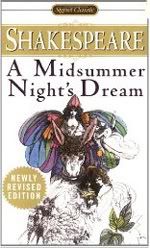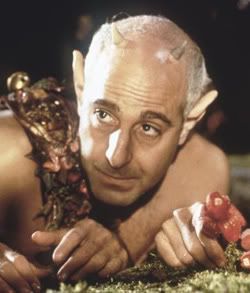A MIDSUMMER NIGHT’S DREAM by William Shakespeare: Thoughts on the Play & Movie
This year, I’m reading one play each month to participate in the Read Shakespeare Challenge hosted by Risa at Breadcrumb Reads. The plays were chosen by poll and then assigned to months by Risa. Thus, in January I read A Midsummer Night’s Dream, a play I likely would not have chosen to read otherwise.
 A Midsummer Night’s Dream
A Midsummer Night’s Dream is one of Shakespeare’s earlier plays, probably written around 1594. Because it is bookended by the wedding of the nobles Theseus and Hippolyta, some scholars have suggested that it may have been written as entertainment for a great wedding, just as Quince’s play was written for the wedding of Theseus and Hippolyta. The wedding most favored in this hypothesis is that of William Stanley, Earl of Derby, whose father and brother had been patrons of Shakespeare’s company. Those nuptials in January, 1595 point to the 1594 composition date.
Most of you already know the basic plot of this play, wherein four young people in various states of requited and unrequited love repair to a wood near Athens one midsummer’s evening. There, complications arise with the fairies, a love potion, mistaken identities – in fact, quite a farce. In the end, of course, all is sorted out, everyone loves the right person and the nobles’ wedding becomes triple nuptials, at which Quince’s tradesmen perform an unwitting parody of a play.
I’m not fond of the fairies/supernatural aspect of the plot; I have limited patience for a farce; and I am uncomfortable with a marriage in which one of the partners is only there because he has been bewitched. Certainly, Shakespeare did a large disservice to women in his portrayal of the groveling Helena.
That said, I admire how Shakespeare wove these stories together and presented Quince’s play within a play.
I was amused at the cat-fight between Helena and Hermia:
How low am I, thou painted maypole? Speak!
How low am I? I am not yet so low
But that my nails can reach unto thine eyes.
I laughed out loud at Lysander remark at Quince’s Prologue:
He hath rid his prologue like a rough colt; he knows not the stop. A good moral, my lord: it is not enough to speak, but to speak true.
I loved some of the poetry. It was truly beautiful.
Love looks not with the eyes, but with the mind,
And therefore is winged Cupid painted blind.
And I appreciated that Shakespeare could write bad poetry deliberately to make a point (as in Quince’s play).
What dreadful dole is here?
Eyes, do you see?
How can it be?
O dainty duck, O dear!
These are rather brief thoughts on the play but as a bonus I’ll comment on the 1999 movie with Kevin Kline, Rupert Everett, and Michelle Pfeiffer, that I watched to continue my research.  Here’s my advice on that: give it a pass. Although I enjoyed watching Stanley Tucci as Puck (proving that I can enjoy watching Stanley Tucci in just about anything), the movie left me cold. It was set at the “turn of the nineteenth century” (which I understood to be 1799-1800), but which is evidently the 1890s. The director couldn’t seem to decide if he was dealing with fairies or with satyrs, complete with orgies and naked (albeit in chest-deep water) nymphs; the classy cat-fight degenerated into a mud wrestling match; and somehow all four human lovers shed every stitch of clothing before awakening the next morning and being told by Theseus (act IV, scene i) to stand up (giving that statement a completely different shade of meaning from the original play.) Note: There are other versions of the movie you could try. It’s popular fodder for Hollywood and was also produced in 1996, 1968 and 1935.
Here’s my advice on that: give it a pass. Although I enjoyed watching Stanley Tucci as Puck (proving that I can enjoy watching Stanley Tucci in just about anything), the movie left me cold. It was set at the “turn of the nineteenth century” (which I understood to be 1799-1800), but which is evidently the 1890s. The director couldn’t seem to decide if he was dealing with fairies or with satyrs, complete with orgies and naked (albeit in chest-deep water) nymphs; the classy cat-fight degenerated into a mud wrestling match; and somehow all four human lovers shed every stitch of clothing before awakening the next morning and being told by Theseus (act IV, scene i) to stand up (giving that statement a completely different shade of meaning from the original play.) Note: There are other versions of the movie you could try. It’s popular fodder for Hollywood and was also produced in 1996, 1968 and 1935.
All told, I’m glad I’m finished with A Midsummer Night’s Dream.
What about you? Did you love it?
For Canadian readers:
A Midsummer Night’s Dream
Kindle edition:
A Midsummer Night’s Dream (with notes and detailed explanations for students)

